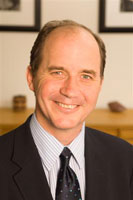The ability to “connect the dots” — work the connections between local conditions and global forces, and between the non-profit, private and government sectors — is necessary whether you work in the private sector or for a conservation group, according to Carter S. Roberts, president and CEO of the U.S. World Wildlife Fund (WWF).
During a recent Wharton Leadership Lecture, Roberts cited one of his mentors, the late John C. Sawhill, as an example of a person with that ability. Sawhill became president of New York University at age 38, served as deputy energy secretary under President Carter, worked in the private sector and then headed The Nature Conservancy (TNC) for a decade before his death in 2000. “He had done it all,” Roberts said of Sawhill. “The people most in demand are the people who can connect the dots between sectors.”
Roberts heads the World Wildlife Fund’s U.S. office at a time when the organization is aggressively partnering with businesses, governments, academia and other non-profits to achieve its conservation goals. “I see two of the most destabilizing forces in the world as being climate change and resource scarcity,” Roberts said, noting that these forces pose both challenges and opportunities for business.
“There’s a reason Goldman Sachs has a major environmental program,” he stated. Goldman Sachs “also sees opportunity. It is always thinking ahead.” Indeed, he added, companies like Wal-Mart, Coca-Cola and HSBC, which have each partnered with WWF on separate initiatives, “are thinking 50 years out.” In 2006, Wal-Mart announced plans to purchase all of its wild-caught fresh and frozen fish for the North American market from Marine Stewardship Council (MSC)-certified fisheries within three to five years. WWF co-founded the Marine Stewardship Council in 1997. The “shockwaves” that Wal-Mart’s announcement sent through the seafood industry have been “amazing,” Roberts said.
In June 2007, Coca-Cola announced a multi-year partnership with WWF focused on water conservation. E. Neville Isdell, Coca-Cola’s chairman and CEO, stated at the time: “Our goal is to replace every drop of water we use in our beverages and their production. For us, that means reducing the amount of water used … recycling water used for manufacturing processes so it can be returned safely to the environment, and replenishing water in communities and nature through locally relevant projects.” Coca-cola is the largest corporate buyer of sugar in the world, Roberts noted. “A bottle of Coke requires 140 liters of water to produce,” largely because of the amount of water needed to produce sugar.
By focusing on water conservation and aiming for water neutrality in five years, Roberts said, Coca-cola is preserving both its future business — water is the main ingredient in every beverage the company makes — and also goodwill within its global markets.
The WWF’s targeting of major retailers and wholesalers to promote sustainable production of seafood, forest products and agricultural commodities — instead of waging grassroots campaigns to change consumer behavior or attempting to influence production in the field — is intentional, said Roberts. “Instead of trying to influence what you choose, we try to influence the choices you’re given.” A veteran of previous management and marketing positions with Gillette and Procter & Gamble, Roberts noted that “when Wal-Mart said, ‘Jump!’ more often than not, we said, ‘How high?’ They own the power in the relationship. They decide what to put on the shelf.”
A 10-year Plan
The mission of the World Wildlife Foundation, founded in 1961 at the instigation of British biologist Sir Julian Huxley, is the conservation of nature. The group seeks to protect natural areas and wild populations of plants and animals, encourage sustainable approaches to the use of renewable resources, and promote more efficient use of resources and energy while also reducing pollution.
Composed of a network of autonomous and associate offices, the WWF works in 100 countries, with approximately 4,000 staff worldwide, and is supported by five million members (1.2 million in the United States). The International WWF is headquartered in Gland, Switzerland; the headquarters of the autonomous U.S. World Wildlife Fund is in Washington, D.C. The WWF estimates that 83% of its spending is directed to worldwide conservation activities.
In late 2005, WWF-US, in consultation with its European counterparts, embarked on a 10-year plan to conserve a priority portfolio of 19 places ranging from the Amazon to the Yangtze and including the world’s largest and most intact tropical forests, the three most diverse freshwater systems in the world, the most diverse coral reefs on earth, the world’s most biologically significant desert and the world’s most productive fishery.
According to Roberts, the WWF has to limit its focus to those priorities in order to make a significant impact. Otherwise, he said, “You condemn yourself to do just little bits and pieces.” The organization is currently in the middle of the “painful” process of “exfoliating” those projects not on the priority list, spinning off programs to other conservation groups, for example. Within each priority project, the WWF wants to create local programs — with local leaders. “You listen,” said Roberts. “You don’t impose the strategy from above. You let the strategy emerge from local conditions.”
In each priority region, WWF also wants to work up the economic chain. For example, “The Amazon is getting pulled apart by deforestation to plant soy,” Roberts noted. “All that soy is going to feed pigs and chickens in China. So if you want to save the Amazon, you’ve got to go to China.” The idea is that if one wants to preserve the Amazon, it is necessary to recognize the market forces at play. In this case, the Amazon’s natural forest land is being cleared for agricultural production that is supplying growing market demand from countries like China.
The challenge now, in each region, is: “How do we find leaders who can connect the dots — between tigers in Sumatra, the biggest pulp and paper company, and Staples, which is the biggest paper buyer in the U.S.?” In 2004, the WWF campaigned for the preservation of Sumatra’s lowland rainforests — prime tiger territory — by pressuring paper companies to institute logging moratoriums in the region. At the same time, the WWF called on U.S. office-supply retailers that buy paper products sourced from those companies to stop unsustainable logging operations.
Roberts noted that the WWF faces a “really interesting branding issue: More and more of our work is about people — people depend on the Amazon and coral reefs to survive, for example — but our logo looks like this.” He pointed to the familiar panda logo on the whiteboard screen. “Most of our work is in the developing world because that’s where the biodiversity is. In all those countries, their number-one priority is not biodiversity; it’s poverty.” So the WWF works to show how conservation issues align with the development and sustainability of local economies.
Conservation and Business
Roberts’ speech underscored how business is already weighing conservation issues. For example, the WWF in late 2006 partnered with The Woods Institute for the Environment at Stanford University and The Nature Conservancy for a 10-year venture called “The Natural Capital Project.” The project seeks to develop new scientific methods, new financial instruments and new governmental policies to incorporate the value of ecosystems in resource decisions.
Since 1998, the WWF and the World Bank have worked together to curb deforestation. The goal of the WWF/World Bank alliance, renewed in 2005, is to reduce the rate of global forestation by 10% in 2010, target “zero-net deforestation” by 2020 and begin to improve global forest cover to better than its 2000 level by 2050.
Roberts noted that when it comes to climate change, business is “way ahead of the federal government.” Rather than having 20 different state laws on climate change, business would prefer one set of federal requirements. “We’re a non-partisan group,” Roberts stated, “but this administration has not been good on climate change …. We’re finding now that corporate leaders want to make the investments in the type of plants and the type of markets that they know will address the issues of climate change. But they don’t want to suffer compared to their competitors for doing that.” The dynamic is global. “China is not going to make major commitments unless the U.S. makes major commitments,” Roberts added. It doesn’t want to lose “its competitive edge.”
Jumping on Trains, Hiking up Mountains
Roberts subscribes to what he calls the “Bushwhacking Theory of Life,” which is that “it’s a lot more interesting to find your own way from here to there rather than trudging along a trail that somebody [has already] made.” He bushwhacked his way into his current non-profit career after leading management teams at Procter & Gamble’s Gillette brand, and also working as an account executive with Dun & Bradstreet. He holds an MBA from Harvard University and an undergraduate degree from Princeton University.
He was, he says, a “wild child of sorts,” growing up in an Atlanta neighborhood where he and his friends “would pop manhole covers and disappear into the sewer system, wandering through the neighborhood underground. We would jump trains and do a lot of [rock] climbing.” He went to college but “spent almost every weekend climbing in the White Mountains [of New Hampshire], sometimes [going on] to Alaska.” During those hikes, he would think about what he was doing with his life and what he cared about, “often looking out over a landscape that was changing before my very eyes.”
When he graduated, “environmental groups were only hiring lawyers and scientists — scientists to do research, lawyers to sue people. None of that was compelling to me.” He interviewed with top-tier companies like Goldman Sachs and a few start-ups as well. “It [requires] a force of will not to take that path,” he said, “because those organizations are so good at recruiting and [offering] incentives.”
After working in the private sector, he was hired in 1990 as The Nature Conservancy’s state director for Massachusetts, leaving in 2004 as vice president for strategic planning and global priorities. He also served as vice president for TNC’s Central America Division. Roberts joined the World Wildlife Fund as chief conservation officer and COO in March 2004. He was promoted to his current role in July 2005 when Kathryn S. Fuller stepped down after 16 years as WWF’s president and CEO.
As for the difference between working in the private sector versus running a non-profit, Roberts noted that “You definitely don’t make as much money…. And I work harder than I ever did in the private sector. It’s not for the faint of heart.” What makes working for the WWF harder is an increased sense of responsibility, he added. “Climate change, saving the Amazon, is little bit different than moving up the stock price.”
He urged his audience to take risks early in their career, before mortgages, children and other responsibilities come into their lives. Taking risks can “stretch you way beyond the expectations of your parents and your peers. Everyone I have known who has done that treasured those moments. It made them see the world in a different way and introduced new opportunities.”
He also praised the value of mistakes. “As you take risks, you are going to make mistakes. Take the time to learn from those mistakes. You’re going to get a lot of feedback, I guarantee you.” And, he added, “listen more than you talk. I made a lot of mistakes by not listening enough. I continue to learn that lesson.” Roberts also recommended that people “find a mentor who is a superb leader and learn from [him or her]…. Watch how they operate. Watch how they move.” In addition to TNC’s Sawhill, his mentors have included current Treasury Secretary Hank Paulson and former Goldman Sachs general partner Larry Linden.
Roberts also hammered home the importance of constant communication. “You can never err on the side of communication as a leader,” he said. “In the absence of communication, you will be surprised by the incredible things they assume about you…. It’s great to have a vision, but where I see people fall down” is when they fail to “communicate that vision in every way, shape and form, every second of the day.”
In September 2006, Roberts found himself faced with a huge crisis when 23 people — WWF employees, high-level government representatives and crew members — died in Nepal after their helicopter slammed into a mountain on the way back from a WWF ceremony. Roberts contacted all the families, from eight different nationalities and 12 different religious traditions, to tell them that their loved ones had died. He flew to Katmandu to help ID the remains and also sit with the families and attend funerals.
Roberts said he and the WWF made it a point to remain very focused on the grieving families and their needs. “There is nothing in your career in business school that will prepare you for these moments, yet at some point something like that will happen to you as a leader,” he said. “The organization watches you and takes its cues” based on “how you feel about the organization and how you care about the people who are there.”
Finally, he recommended that his audience begin thinking about their legacy now. “I have the great fortune to work with business leaders around the world,” he said. “All made it big time, but they are obsessed with what they are going to leave behind. I would just suggest to you that you think now, before you get to that point, about what you want your legacy to be.”
As Roberts was addressing his audience, the United Nations Climate Change Conference (UNCCC) 2007 meeting, held in Bali, was entering the fourth of its 11 days in which political leaders debated a legally binding framework to tackle climate change. Approximately 60 WWF staff members from around the world were there “pushing every lever we can” to change the outcome of global warming.
Representatives of more than 180 countries, as well as observers from intergovernmental and non-governmental organizations, attended the UNCCC. Roberts noted each of the attending countries are approaching the issue of climate change from diverse perspectives. “Some have forests; some don’t. Some have factories; some don’t.” The conference, he added, is “all about resolving different national and commercial circumstances” to work towards a global agreement.



